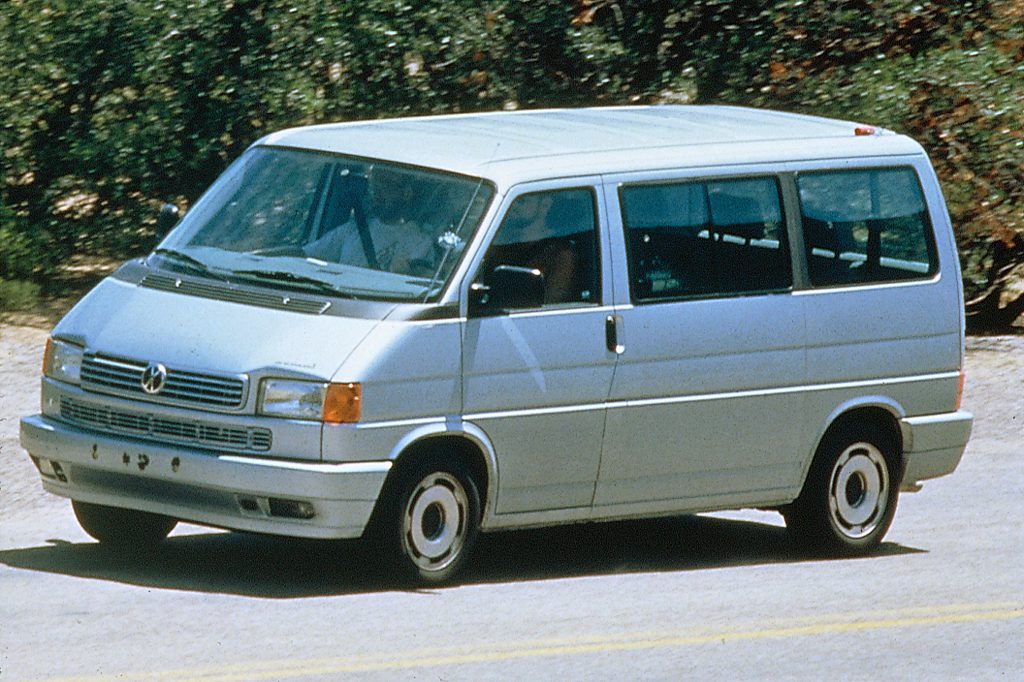| Minivan; Built in Germany, USA |
|
|
| Good condition price range: $1,200 – $12,700* |

1996 Volkswagen EuroVan

1999 Volkswagen EuroVan interior

1995 Volkswagen EuroVan Camper

1993 Volkswagen EuroVan GL

1999 Volkswagen EuroVan GLS

1995 Volkswagen EuroVan Camper
| Pros: |
|
| Cons: |
|
For shoppers who favor strictly practical virtues, a EuroVan might be worth the price, though not many are on the used-car market. Those who seek stylishness, performance, or car-like comfort will have to look elsewhere.
Overview
Introduced in spring of 1992, as a 1993 model, Volkswagen’s EuroVan replaced the rear-engined, rear-drive Vanagon, which left the lineup in fall 1991. EuroVan had its 109-horsepower, 2.5-liter 5-cylinder engine up front, driving the front wheels. A 5-speed manual transmission was standard, with 4-speed automatic optional.
EuroVan came in CL and GL trim, along with a camper-oriented MV model. All versions rode a 115.0-inch wheelbase and measured 186.6 inches long overall, compared to 97 and 180 inches for the Vanagon.
Base CL and midlevel GL models seated seven, with a 2-seat center bench and a 3-place rear bench. The MV also seated seven but had a pair of rear-facing middle buckets, a swing-up middle table, and a rear bench that folded into a bed. An optional Weekender Package for the MV included a pop-up roof with an integral double bed, plus a refrigerated cooler and screened, curtained windows.
Front and rear air conditioning were standard on GL and MV models, optional on CL. Antilock brakes were optional, but a driver’s airbag was not available.
Yearly Updates
| 1994 EuroVan No 1994 EuroVans were issued, as Volkswagen planned to launch a revised version in the spring of that year, as an early ’95 model. |
| 1995 EuroVan Volkswagen had planned to introduce a revised EuroVan with dual airbags for 1995, but retreated from that intention. No regular 1995 EuroVans were marketed, but a small number of EuroVan Campers, built with the assistance of Winnebago Industries, went on sale through certain VW dealerships. Campers rode a stretched wheelbase, measuring 130.7 inches instead of the usual 115-inch. Seating for four was standard. An optional 2-place middle bench increased seating capacity to six. The middle and 2-place rear bench seats were removable, and the middle seat could also face rearward. Front bucket seats pivoted 360 degrees. A 2-person sleeping room popped out of the roof, and a wardrobe closet sat behind a sliding door. The built-in kitchen includes a 2-burner LP gas range, a refrigerator, stainless-steel sink, cabinets, and a 12-gallon water tank. |
| 1996 EuroVan Once again, Campers were the only EuroVans on the market. |
| 1997 EuroVan For the third year in a row, only Campers were marketed. |
| 1998 EuroVan Campers again were the only EuroVans to be found in the U.S. market. |
| 1999 EuroVan Volkswagen revived the regular EuroVan for 1999, modifying the basic 1993 design, freshening the interior and installing a V6 engine, as well as dual airbags. GLS and MV (Multivan) models went on sale. Rated at 140 horsepower, the 2.8-liter VR6 was modified to yield more torque in the EuroVan than it did in other Volkswagen models. A 4-speed automatic was the only transmission. A EuroVan could tow a 4400-pound trailer (if equipped with brakes), and had a cargo capacity of half a ton. Low-speed traction control was standard. EuroVans had fully independent suspension, rack-and-pinion steering, and antilock braking. The body was strengthened, with reinforced floor panels and stronger B/C pillars. Daytime running lights were installed, as well as a child safety lock for the sliding door. Standard GLS equipment included power windows, a pollen/dust filter, air conditioning, power locks, cruise control, 6-speaker cassette stereo, intermittent wipers, heated windshield-washer nozzles, rear wiper/washer, and power mirrors. Seating seven, the GLS had a forward-facing center bench and a 3-place rear bench. The MV also seated seven, but had two separate rear-facing seats and a triple rear bench. An optional Weekender Package for the MV included a pop-up roof with 2-person bed, full-swiveling captain’s chairs, window screens for two side sliding windows, a second battery, and a fixed left rear-facing seat with a refrigerator stowed beneath its lift-up seat bottom. Extended-wheelbase Camper versions remained on sale. |
| 2000 EuroVan Second-row bucket seats became available for the GLS model this year. New features included rear-seat reading lights, tinted rear glass, and remote central locking. |
| 2001 EuroVan EuroVan’s engine was substantially revised and gained 61 horsepower. Antiskid system and rear child-seat anchors were also added. |
| 2002 EuroVan There were no significant changes for 2002. |
| 2003 EuroVan Unchanged for the second straight year. Due to slow sales the EuroVan was dropped at the end of 2003. |
